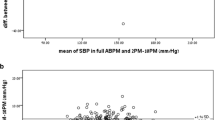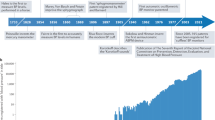Abstract
We evaluated the consequences of excluding the first of three blood pressure (BP) readings in different settings: a random population sample (POS, n=1525), a general practice office (GPO, n=942) and a specialized hypertension center (SHC, n=462). Differences between systolic and diastolic BP (SBP and DBP) estimates obtained including and excluding the first reading were compared and their correlation with ambulatory BP monitoring (ABPM) was estimated. The samples were divided into quartiles according to the difference between the third and the first SBP (3-1ΔSBP). SBP decreased through sequential readings, 3-1ΔSBP was −5.5±9.7 mm Hg (P<0.001), −5.1±10.4 mm Hg (P<0.001) and −6.1±9.3 mm Hg (P<0.001) for POS, GPO and SHC, respectively. However, individuals included in the top quartile of 3-1ΔSBP showed their highest values on the third reading. The mean SBP estimate was significantly higher excluding the first reading (P<0.001), but the differences among both approaches were small (1.5–1.6 mm Hg). Moreover, the correlation between SBP values including and excluding the first reading and daytime ABPM were comparable (r=0.69 and 0.68, respectively). Similar results were observed for DBP. In conclusion, our study does not support the notion of discarding the first BP measurement and suggests that it should be measured repeatedly, regardless the first value.
This is a preview of subscription content, access via your institution
Access options
Subscribe to this journal
Receive 12 digital issues and online access to articles
$119.00 per year
only $9.92 per issue
Buy this article
- Purchase on Springer Link
- Instant access to full article PDF
Prices may be subject to local taxes which are calculated during checkout



Similar content being viewed by others
References
Parati G, Mancia G . Assessing the white coat effect: which blood pressure measurement should be considered? J Hypertens 2006; 24: 29–31.
Mancia G, Fagard R, Narkiewicz K, Redón J, Zanchetti A, Böhm M et al. 2013 ESH/ESC Guidelines for the management of arterial hypertension: the task force for the management of arterial hypertension of the European Society of Hypertension (ESH) and of the European Society of Cardiology (ESC). J Hypertens 2013; 31: 1281–1357.
Hackam DG, Quinn RR, Ravani P, Rabi DM, Dasgupta K, Daskalopoulou SS et al. The 2013 Canadian Hypertension Education Program recommendations for blood pressure measurement, diagnosis, assessment of risk, prevention and treatment of hypertension. Can J Cardiol 2013; 29: 528–542.
Muntner P, Shimbo D, Tonelli M, Reynolds K, Arnett DK, Oparil S . The relationship between visit-to-visit variability in systolic blood pressure and all-cause mortality in the general population: findings from NHANES III, 1988–1994. Hypertension 2011; 57: 160–166.
Muntner P, Levitan EB, Reynolds K, Mann DM, Tonelli M, Oparil S et al. Within-visit variability of blood pressure and all-cause and cardiovascular mortality among US adults. J Clin Hypertens (Greenwich) 2012; 14: 165–171.
Salazar MR, Carbajal HA, Aizpurúa M, Riondet B, Rodrigo HF, Rechifort V et al. Decrease of blood pressure by community-based strategies. Medicina (B Aires) 2005; 65: 507–512.
Salazar MR, Carbajal HA, Espeche WG, Aizpurúa M, Leiva Sisnieguez CE, March CE et al. Identifying cardiovascular disease risk and outcome: use of the plasma triglyceride/high-density lipoprotein cholesterol concentration ratio versus metabolic syndrome criteria. J Intern Med 2013; 273: 595–601.
National Clinical Guideline Centre (UK). Hypertension: The Clinical Management of Primary Hypertension in Adults: Update of Clinical Guidelines 18 and 34 [Internet]. Royal College of Physicians (UK): London, 2011.
Graves JW, Grossardt BR . Discarding the first of three nurse-auscultatory or oscillometric blood pressure measurements does not improve the association of office blood pressure with ABPM. Blood Press Monit 2010; 15: 146–151.
Mengden T, Hernandez Medina RM, Beltran B, Alvarez E, Kraft K, Vetter H . Reliability of reporting self-measured blood pressure values by hypertensive patients. Am J Hypertens 1998; 11: 1413–1417.
Parati G, Stergiou GS, Asmar R, Bilo G, de Leeuw P, Imai Y et al. ESH Working Group on Blood Pressure Monitoring European Society of Hypertension practice guidelines for home blood pressure monitoring. J Hum Hypertens 2010; 24: 779–785.
Graves JW, Grossardt BR, Gullerud RE, Bailey KR, Feldstein J . The trained observer better predicts daytime ABPM diastolic blood pressure in hypertensive patients than does automated (Omron) device. Blood Press Monit 2006; 11: 53–58.
Handler J, Zhao Y, Egan BM . Impact of the number of blood pressure measurements on blood pressure classification in US adults: NHANES 1999–2008. J Clin Hypertens (Greenwich) 2012; 14: 751–759.
Lewington S, Clarke R, Qizilbash N, Peto R, Collins R . Prospective Studies Collaboration. Age-specific relevance of usual blood pressure to vascular mortality: a meta-analysis of individual data for one million adults in 61 prospective studies. Lancet 2002; 360: 1903–1913.
Floras JS . Blood pressure variability: a novel and important risk factor. Can J Cardiol 2013; 29: 557–563.
Kikuya M, Ohkubo T, Metoki H, Asayama K, Hara A, Obara T et al. Day-by-day variability of blood pressure and heart rate at home as a novel predictor of prognosis: the Ohasama Study. Hypertension 2008; 52: 1045–1050.
Acknowledgements
This study could not have been conducted without the help of the nurses from the ‘Hospital Municipal, San Andrés de Giles’ and the ‘Hospital Municipal, Rauch’ and the nurse Miriam Susana Cor from the ‘Hospital Universitario San Martín, La Plata’. We appreciate the help of Sonja Zander in the revision of the English of this manuscript.
Author information
Authors and Affiliations
Corresponding author
Ethics declarations
Competing interests
The authors declare no conflict of interest.
Rights and permissions
About this article
Cite this article
Salazar, M., Espeche, W., Aizpurúa, M. et al. Should the first blood pressure reading be discarded?. J Hum Hypertens 29, 373–378 (2015). https://doi.org/10.1038/jhh.2014.98
Received:
Revised:
Accepted:
Published:
Issue Date:
DOI: https://doi.org/10.1038/jhh.2014.98
This article is cited by
-
Association of ambulatory blood pressure with coronary microvascular and cardiac dysfunction in asymptomatic type 2 diabetes
Cardiovascular Diabetology (2022)



